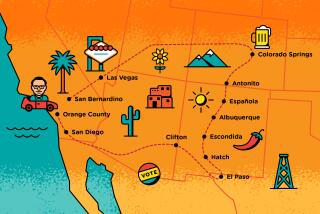An Idealistic Leader in a Troubled State
- Share via
THE ROAD TO SANTA FE
A Novel
by Norman Zollinger
Forge
364 pages, $25.95
“The Road to Santa Fe” is a fast-paced contemporary political novel about the small group of characters who run one of the larger, least populous, poorest and most complicated states in the union: New Mexico.
Norman Zollinger, who died in 2000 after the book was finished, lived in the Albuquerque area and wrote a number of well-regarded novels about the Western regions. He knew the territory and the people of New Mexico. The scenery and the inhabitants of the state are all there in “The Road to Santa Fe”: the august Latino patron of the northern mountainous counties, where the descendants of the conquistadores have lived in uneasy isolation for 400 years; the cattle-running families on the plains in “Little Texas” in the Southeast; the jostling urban life of Albuquerque, where remnants of the earlier red-neck culture coexist uneasily with the well-to-do miners, oilmen and rising corporate lawyers who hang out at the Petroleum Club.
There are also the young Hispanics, pulling themselves up into the slightly larger and certainly dominant Anglo society by virtue of their newly won credentials from the University of New Mexico in Albuquerque and New Mexico State in southern Las Cruces.
And always, off to one side, are the Pueblo Indians, proud, slightly aloof, wrapped in their ancient religions and several languages, touched, if only partially, by their ancient and ambivalent conversion to Catholicism by the invading Spaniards of the 16th century.
Into this complicated ethnic and economic mix, in a state of only 1.8 million people, Zollinger deftly constructs a tale that defines the plausible characters he creates and illuminates the milieu in which they move and act.
The principal character is Rick--Enrique--Garcia, who went from the university to Georgetown’s law school. He is back home in a small, no-count imaginary county south of Albuquerque and east of the Rio Grande. He has married the Anglo daughter of one of the area’s prominent ranching families, a woman beset by a devastating bipolar illness neither she nor her therapists can lift from her. She kills herself: Rick, shattered and infinitely lonely, eventually pulls himself up and follows a youthful dream by running for district attorney. Even in this predominantly Anglo district, he wins. (Such things do happen in New Mexico.)
Garcia finds himself prosecuting a prominent and popular Anglo county man, with whom he played football in high school, for willfully and scandalously building a mining catchment pond that violates all contemporary safety standards for such environmental safeguards. Three Latino children died by drinking the pond water.
Garcia sends the defendant to the penitentiary in Santa Fe. The convict vows revenge, even death. Very much on the surface in this trial is the resentment in the community felt toward people like Garcia, whom they habitually call “Messkins.” Just under the surface is the common Anglo attitude that the lives of Indian children aren’t worth very much.
There runs through “The Road to Santa Fe” a troubling moral element: Garcia wooed and won his first wife away from the man he later sent to jail. Buoyed by his success as district attorney and pulled by the lure of practical, idealistic leadership for a state long troubled by a dispiriting combination of corruption and indifference, Garcia is persuaded by a bright political operative and her stalwart, high-minded father to run for the Democratic nomination for governor.
Some chunks of money come in to start him on his way. (In New Mexico $50,000 is a substantial contribution to a governor’s race.) In an amusing vignette, Garcia gets briefly involved with a rich San Francisco woman, who, like some outsiders, makes herself into an “instant Santa Fe-an” by wearing long voluminous skirts, Navajo velveteen blouses and spectacular silver-and-turquoise squash-blossom necklaces. Garcia faces hazards on his bid for the governor’s seat. In true New Mexico style, they are serious and grim.
“The Road to Santa Fe” is a brisk read with authentic, recognizable characters.
It is, to boot, a handsome portrait of what Garcia, flying south in a small plane along the Rio Grande, accurately calls “this astonishing state.”
More to Read
Sign up for our Book Club newsletter
Get the latest news, events and more from the Los Angeles Times Book Club, and help us get L.A. reading and talking.
You may occasionally receive promotional content from the Los Angeles Times.










